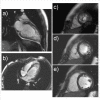Cardiovascular magnetic resonance findings in a pediatric population with isolated left ventricular non-compaction
- PMID: 22293172
- PMCID: PMC3289040
- DOI: 10.1186/1532-429X-14-9
Cardiovascular magnetic resonance findings in a pediatric population with isolated left ventricular non-compaction
Abstract
Background: Isolated left ventricular non-compaction (LVNC) is an uncommon disorder characterized by the presence of increased trabeculations and deep intertrabecular recesses. In adults, it has been found that ejection fraction (EF) decreases significantly as non-compaction severity increases. In children however, there are a few data describing the relation between anatomical characteristics of LVNC and ventricular function. We aimed to find correlations between morphological features and ventricular performance in children and young adolescents with LVNC using cardiovascular magnetic resonance (CMR).
Methods: 15 children with LVNC (10 males, mean age 9.7 y.o., range 0.6-17 y.o.), underwent a CMR scan. Different morphological measures such as the compacted myocardial mass (CMM), non-compaction (NC) to the compaction (C) distance ratio, compacted myocardial area (CMA) and non-compacted myocardial area (NCMA), distribution of NC, and the assessment of ventricular wall motion abnormalities were performed to investigate correlations with ventricular performance. EF was considered normal over 53%.
Results: The distribution of non-compaction in children was similar to published adult data with a predilection for apical, mid-inferior and mid-lateral segments. Five patients had systolic dysfunction with decreased EF. The number of affected segments was the strongest predictor of systolic dysfunction, all five patients had greater than 9 affected segments. Basal segments were less commonly affected but they were affected only in these five severe cases.
Conclusion: The segmental pattern of involvement of non-compaction in children is similar to that seen in adults. Systolic dysfunction in children is closely related to the number of affected segments.
Figures





References
-
- Ganame J, Ayres N, Pignatelli R. Left Ventricular Noncompaction, a Recently Recognized Form of Cardiomyopathy. INSUFICIENCIA CARDIACA. 2006;1(3):119–124.
-
- Jenni R, Oechslin E, Schneider J, Attenhofer Jost C, Kaufmann PA. Echocardiographic and pathoanatomical characteristics of isolated left ventricular non-compaction: a step towards classification as a distinct cardiomyopathy. Heart. 2001;86(6):666–671. doi: 10.1136/heart.86.6.666. - DOI - PMC - PubMed
-
- Chin TK, Perloff JK, Williams RG, Jue K, Mohrmann R. Isolated noncompaction of left ventricular myocardium. A study of eight cases. Circulation. 1990;82(2):507–513. - PubMed
Publication types
MeSH terms
LinkOut - more resources
Full Text Sources
Medical

